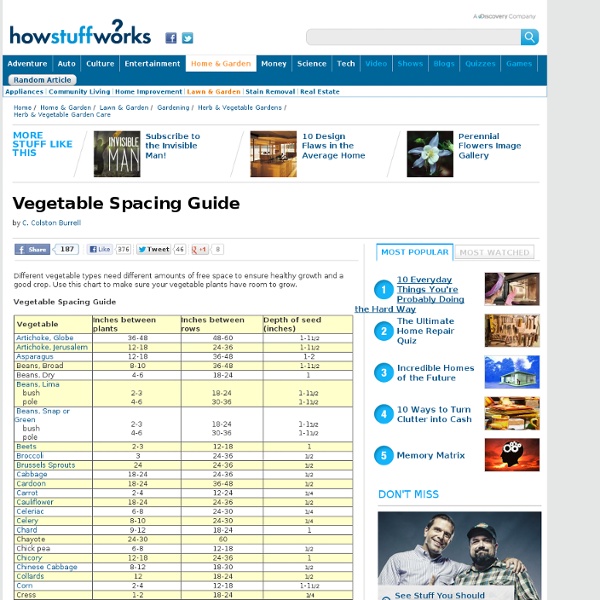Zoom
Trash
Related: Planting



http://home.howstuffworks.com/vegetable-spacing-guide.htm
Related: PlantingSelf-Seeding Crops You’ll Never Need to Replant One of the characteristics of a truly sustainable garden is that it produces at least some of its own seed. This is most often done when gardeners select, harvest and store seeds until the proper time for planting the following year. But some self-seeding crops produce seeds so readily that as long as you give them time to flower and mature, and set seed, you will always have free plants growing in your garden. You can simply let the seeds fall where they are, or toss pieces of the seed heads into the corners of your garden, or whichever area you want them in — no harvesting, storing or replanting required. With most self-seeding vegetables, herbs and annual flowers, you’ll just need to learn to recognize the seedlings so you don’t hoe them down.
The Only 25 Baby Gear Items You Really Need Image: iStockphoto/Thinkstock You’re pregnant! This is an exciting time, but it can also be very overwhelming. Besides the fact that your whole world is about to change, the baby marketers (err, vultures) are trying to get you to buy every baby product on the market. I was very cautious of this because, like many young couples, we were living in a small space when we had our first baby. Do I really need a glider?
Guide to Growing Vegetables Some general considerations for growing vegetables: Sowing Tips When sowing seeds, a good general rule of thumb is to sow to a depth of approximately twice the thickness of the seed. Easy vegetables to grow Planting a garden doesn’t have to be a huge undertaking. But the fear of failure keeps many a gardener-wannabe from spending time and energy on planting backyard crops. Knowing the easy vegetables to grow for your region — in addition to when and where to plant them — is the best way to ensure success. 50 of the Best Uses for Coconut Oil - Sunwarrior News 50 of the Best Uses for Coconut Oil 4.14/5 (82.72%) 389 votes Coconut oil has a bit of a craze surrounding it lately. People have put together hundreds of different uses for this beneficial oil and it’s found its way into pantries, medicine cupboards, and even first aid kits. Some of the uses may seem bizarre at first, but coconut oil has garnered this newfound fame for good reason. It works. For years, coconut oil has had a bad name, lumped in with unhealthy saturated fats.
Growing Celery Indoors: Never Buy Celery Again Remember when we tested and shared how to grow onions indefinitely last week? Well, at the same time, we've been testing out another little indoor gardening project first gleaned from Pinterest that we're excited to share the successes of today — regrowing celery from it's base. We've figured out how to literally re-grow organic celery from the base of the bunch we bought from the store a couple weeks ago. I swear, we must have been living under a rock all these years or just not be that resourceful when it comes to food, but we're having more fun learning all these new little tips and tricks as we dive deeper into trying to grow more of our own food.
Bottles "Pop" - DIY Garden Edging Put some imagination—and recycled products—to good use in your landscape with inventive DIY garden edging. Photo: gardeningescapes.com 8 Vegetables That You Can Regrow Again And Again. Scallions You can regrow scallions by leaving an inch attached to the roots and place them in a small glass with a little water in a well-lit room. wearenotfoodies.com Garlic 15 House Plants You Can Use As Air Purifiers Posted by admin on Thursday, February 18, 2010 · 68 Comments Here are 15 plants that could clean your air for just the price of a few drops of water each day. First lets check some of the evidence behind the claim that plants can purify your household air:
Just in Time for Winter: How to Build Your Own Mini-Greenhouse Gardeners looking to extend the growing season into winter can do so with a cold frame. These handy mini-greenhouses trap heat and keeping cool-season veggies growing in spite of frosty weather. Cold frames are inexpensive to build and don't consume a lot of energy. They yield fresh, local vegetables when mediocre grocery store fodder is being shipped from afar. Just in Time for Winter: How to Build Your Own Mini-Greenhouse Gardeners looking to extend the growing season into winter can do so with a cold frame. These handy mini-greenhouses trap heat and keeping cool-season veggies growing in spite of frosty weather. Cold frames are inexpensive to build and don't consume a lot of energy.
10 Tips For Minimizing Transplant Shock 1. Select the healthiest looking plants at the nursery. You’re paying your hard-earned money for your trees and shrubs, so you have a right to demand the very best plants your money can buy. Inspect them carefully before buying. Adventures in Field Botany / Illustrated-Glossary Leaf Morphology: Phyllode/ Cladode: modifyed stems that act as leaves. Ensiform: leaves sharp edges, taper into a slender point (fern)